A man wanted for assaulting a Kirkland police officer was shot by Renton police today in Kennydale (a couple blocks from my home).
Here is the story in the Seattle Times.
A man wanted for assaulting a Kirkland police officer was shot by Renton police today in Kennydale (a couple blocks from my home).
Here is the story in the Seattle Times.
After one and a half hours of debate last night, Renton City Council voted 5 to 2 to send the Shoreline Master Plan to the Department of Ecology for their review and approval.
While we spent some time discussing parks impacts and public access provisions, the main topic of debate was the way we manage existing bulkheads on the shoreline. The epicenter of the argument was the interpretation of section 173-26-231 (click here to read it) of the Washington Administrative Code, and whether it says that existing bulkheads need to be removed from the lake or river if they are still serviceable and not being proposed for alteration by the property owner. I argued that as written this section pertains only to shoreline “Modifications” not to shoreline pre-existing conditions. City staff and a Department of Ecology Official insisted that this section of the WAC also applied to existing bulkheads that are not being modified, and required that shoreline bulkheads be considered for possible removal whenever there is a change of use, or a significant expansion of an existing use, in the upland areas of a property.
This distinction was a big deal, because the required evaluation can be expensive for individual homeowners, the results of these studies can be unpredictable, and if the review says that the shoreline must be revised then the process to actually alter the shoreline can take years (federal and state permitting is complex). Furthermore, the bulkheads give peace-of-mind to property owners and their lenders as they protect primary structures and utilities from damage in storms.
The Council Committee of the Whole ultimately voted five-to-two to adopt a committee report recommending that the SMP be forwarded to the Department of Ecology for review and approval. (It is widely understood that once this DOE review is complete, the city would have a difficult time changing the words, which is why last night’s decision was so important.)
Marcie Palmer and I offered a “Committee of the Whole Minority Report” which had almost all the same language as the page-and-a-half long Majority Report, but included four additional provisions. (1) Tables should be clarified to be specific that they only apply within the shoreline buffer for each site, (2) Language should be changed so that existing shoreline stabilization that is still serviceable and is not being proposed to be revised by the property owner can be retained, (3) Typos in the document should be identified and fixed, (4) Council will evaluate providing credit against the Parks Mitigation Fee to projects that provide public access to the water.
At the council meeting a half hour later, the majority report was formally adopted in lieu of ours, which did not surprise me or Marcie given the 5-to-2 Committee of the Whole decision. (It’s the same people voting in Committee of the Whole and on Council). So, the majority report essentially only serves as a record of where our differences of opinion were. (Following the vote, Council President Don Persson asked city staff to try to scrub the remaining typos from the document before it is sent to Department of Ecology. Most of the typos had come about from negotiated changes to the document– we were on the seventh draft)
While I obviously wish the council had come over to Marcie’s and my point of view, I am highly appreciative of the entire council for the time they afforded for debate on this topic. Everyone was gracious, even while I (and to a smaller extent Marcie) kept the debate going a long time as we sparred over the complex technical issues involved. Our council works very well together, even when we hold such disparate opinions, and this makes it a sincere pleasure to serve.
The Renton Reporter covered last night’s events in this article today.
Public Access Provisions remain an element of controversy in Renton’s proposed SMP. This is not surprising, as the issue essentially pits the US Constitution (which states “…nor shall property be taken for public use, without just compensation”), against the Public Trust Doctrine, the ancient premise the public ownership of our waterways transcends lawmaking altogether (e.g. no law can take the oceans and certain other waterways away from the public.)
Throughout our county there have been countless legal battles regarding waterway access, that usually come down to balancing the US Constitution and The Public Trust Doctrine. And every law produced by congress, the state, the county, or a city, is subordinate to these two supreme codes. Since the Constitution and the Public Trust Doctrine are both nearly unchangeable and open to broad interpretation, the judicial branch currently has more power to affect laws regarding water access (through case-law decisions) then any legislative body in existence. And courts have been doing so.
Still, the City of Renton has been tasked by the state with developing broad, constitutionally acceptable public access rules for waterfront property in Renton. The State Administrative Code specifically says “Local governments should plan for an integrated shoreline area public access system that identifies specific public needs and opportunities to provide public access. … The planning process shall also comply with all relevant constitutional and other legal limitations that protect private property rights.” So as part of the SMP process, we are attempting to construct our public access laws knowing full well that we are not the final authority, and that we could end up in court like so many other jurisdictions have if we don’t balance the interests just right. (Wish us luck!)
So how do we do it? I can only speak for myself on this topic. Here are some of my most candid thoughts.
Boaters should feel free to travel on our lake, and float down our river, with no interference or admonishment by property owners. If two kids in a rubber raft need to stop in the mud at the edge of the Cedar River to re-inflate their boat, I believe they have that right under the Public Trust Doctrine, even if the upland property owner would prefer they not stop there. Likewise, if a fisherwoman in hip waders wanders in the shallows next to your riverfront property, you should let them fish– they have a supreme right to be in the river.
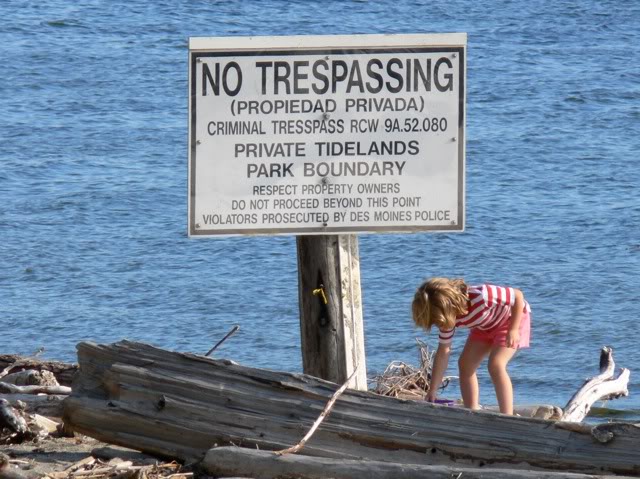
Children on the tide lands getting yelled at by territorial homeowners or their agents is too common in our area. I took this picture after witnessing such an altercation last summer at the edge of Salt Water State Beach. New state shoreline rules, and court decisions in other states favoring the Public Trust Doctrine, suggest that public access to Washington’s waterways will be increasing. This is particularly true of our tide lands, which many people feel are part of the ocean– the argument is that the state never owned the ocean, so it therefore had no right to sell part of it.
If our city bordered Puget Sound, I would be aggressive with public access there as well. If a photographer is looking at tide pools at a public access point on Puget Sound, and they spot an unusual star fish 20 feet away in a tide pool in the tide flats below a private residence, I believe they have a right under the Public Trust Doctrine to scramble to the stafish for a closer look. (Be aware there are waterfront property owners who would disagree with me, and some of them are stubborn; so be prepared to get in a confrontation if you try this. Some will argue that their great-great-grandfather purchased the tide-flat from the state years ago. But a growing body of case law says that the state never owned the sand and tide pools between the low and high tides, and hence could not sell this resource to a private homeowner. This issue has not been resolved in our state.)
Bottom line, I’m progressive on water access. Don’t get between me and a tidepool in THE PUBLIC’S tide-flats, and we won’t get into any arguments. And don’t try to stop me from floating past your property on the PUBLIC’S river, and we will be just fine.
However, once you get above the high water mark of the body of water, public access rights become murkier or non-existent. The sandy areas of saltwater beaches are widely in dispute on this point, because of the presence of annual extreme high and low tides which make the limits of the ocean disputable. Courts have had an easier time finding a bright line for property ownership on freshwater lakefront, when the water line is relatively constant. River boundaries are not as easy to define as lakes, but perhaps easier than salt-water beaches. In all these cases, land which is never underwater is generally assumed to be eligible for private ownership.
This is where the constitution comes in. As a councilman, I have been officially sworn to uphold the US Constitution (along with the laws of the state.) And the fifth amendment of the US Constitution makes it clear that private property can not be taken by the public without “just compensation”. What constitutes “just compensation” is clearly open to debate, but it is often a cash payment. It can be something else of value.
Our proposed SMP asks property owners in some cases to dedicate an easement for a trail across the dry portions of their property (above the high water line), and to physically construct the trail as part of their development. In some circumstances this is required outright, and in others it is a condition of being able to develop a larger project closer to the water.
While I love waterfront trails myself, this could raise the question of whether “permission to build” is in itself “just compensation” for the trail dedication. Evidence in favor– developers often dedicate roads and utilities to the city when they build, as part of the development agreement. Evidence against– these roads and utilities are almost always connected to the development project, and are necessary for access and operation of the building; a waterfront trail for the public is somewhat different. Evidence in favor– we require developers to either build park amenities or contribute to a parks fund when they build. Evidence against–a public waterfront trail may be above and beyond the typical burden placed on a developer, and I do not know if we have offered to waive the parks fee as part of the SMP.
In summary, balancing the public access rights with the private property rights is a complicated and often controversial process. We will discuss this topic as part of our final council deliberations on the SMP tomorrow night.
Click here for more complete text from some of the referenced documents
For those of you following the final SMP approval process, here is an additional email chain we exchanged at city hall yesterday. (Latest email is on top, earliest on the bottom).
For those of you following the final work on the Shoreline Master Program, here is a copy of an email I sent to city hall on Friday summarizing my questions about flood risk and possible parks impacts. (Marcie Palmer raised the parks question on Monday night, so she may be asking her own questions about this).
I believe the staff is also following up on questions raised by the public at last Monday’s council meeting.
_________________________________________
To: Renton Council President Don Persson
Dear Don-
At our last council meeting I raised some questions regarding the SMP that staff offered to look into for me. I appreciate their willingness to follow up on them. I am sending this email to give more specifics about my questions, and a couple examples, in order to hopefully save as much time as possible.
I am interested in hearing from Public Works regarding the risk of increased sedimentation occurring in the Cedar River bed downtown as a result of SMP provisions regarding shoreline stabilization. In particular, I would like confidence that we are not increasing the risk of significant river channel migration (either over time or dramatically during a flood) immediately upstream of our downtown commercial zone, with the resulting dislodged deposits reducing under-bridge flow capacities at Bronson, Wells, Williams and Logan bridges. Since flood water was lapping at the bottoms of several of our bridges in a storm less than two years ago, I am concerned we do not have any capacity left under these bridges. It’s of course a balance– ecological concerns dictate that we have the most natural Cedar River possible, while safety concerns dictate that we keep the river in a strongly defined and stable channel where it travels through the the urban area.
Note that per a suggestion given at the council meeting, I checked on the City of Kent’s SMP as an example of an approved document for a river-front city. When I read through this 203-page document, I could not find any section that required property owners with developed sites to remove existing serviceable bulkheads, whether on the Green River or on a lake. The main discussion of shoreline stabilization on the Green River is focused on the Federal Army Corps of Engineers recommendations to enhance the levees by increasing their width. This would be done as a multi-jurisdiction (federal-state-county-city project), using public funds. There seemed to be nothing in the Kent SMP requiring that existing serviceable bulkheads be removed for work being done in the upland areas of waterfront property (away from the shoreline.) If possible, I would like staff to comment on whether I understand this correctly.
On the issue Marcie brought up about the impact the SMP might have on our waterfront parks, I have similar questions as Marcie.
For example, if we wanted to add over 1000 square feet of additional parking lot, pathways, or sports courts at any of our parks we would consult the table on page 192 of the SMP (under section F-1 –partial compliance for non-single family development), and find we have a “Moderate Alteration”. The table says we would need to (among other things) replace any solid decking on all our piers and docks with light-penetrating surfacing materials. Such a change at Coulon Park could cost millions of dollars, and would require many additional permits for over-water work. (We could also face this same issue at Kennydale Beach Park.) Furthermore, we might find that adding the new light-penetrating surface to the docks is not sensible without simultaneously updating the support structure of the docks (i.e. we don’t want to put a new surface over a support system that only has 10 or 15 years of life left.) This could further complicate our ability to install a simple parking or other improvement.
As a second example, if we were trying to update the restrooms at Kennydale Park, they would likely need a 25% expansion due to ADA rules. The same table in the SMP would identify this as a “Major Alteration” and require that we replace the dock surfaces with light-transmitting materials AND evaluate removal of the shoreline stabilization. ( It probably would be feasible from an engineering standpoint to remove the bulkhead at Kennydale Beach Park, and it may be a good idea sometime in the future, but it does not make sense to me that we would have to require it upon a restroom reconstruction.) This could likely make a restroom upgrade cost-prohibitive and impede gradual improvement of our parks facilities.
I would like to see our Community Services Department analyze this concern so that council knows what the impacts will be if we approve the SMP as written.
Thanks!
Randy Corman
Renton City Council
A Bellevue Councilman has been mauled by a bear !!!… and airlifted to Harborview from the attack site near Lake Wenatchee. He is reportedly in stable condition. Please keep Councilman John Chelminiak in your thoughts and prayers. More information can be found here on King5.com.

Dicks Sporting Goods, called “Retail’s rising star” by this article in Fortune Magazine, is filling the former Joe’s Sporting Goods location at the Landing. Dick’s Sporting Goods is one of six new businesses opening soon at the Landing. (Photo link from Fortune Magazine)
The Landing has formally announced that we will see six great new businesses coming to Renton in the months ahead. Dick’s Sporting Goods, Marshall’s, Eyes on the Landing, Creative Mom Toys, Mucho Burrito, and Fresh Way Pizza will be added to the Landing’s already great lineup of restaurants, retailers, and entertainment. (Prior to this announcement, I think only “Eyes on the Landing” had been officially disclosed to the Renton public.)
This large group of new retailers and restaurants is another great step forward for Renton and the Landing.
Be sure to watch for their openings, and welcome them all to Renton. In addition to offering Rentonites additional attractive and convenient shopping and dining options, all of these businesses contribute financially to the operation of our city. We’re very fortunate to see so many new businesses in the depths of this recession, so let’s make sure we get them all off to a great start! Shop locally to save gas and keep your tax dollars in town.
Bucking the Economy, The Landing in Renton Announces Six New Retailers
Four new retailers and two new restaurants join the mix, bringing total dining options to eleven
RENTON, Wash. – September 20, 2010 – Despite the current economic trends, The Landing in Renton has continued to see sales and leasing success. Many retailers and restaurants at The Landing have experienced double digit sales growth every month in 2010 over 2009 giving confidence to new retailers to move to the South Sound’s most dynamic new shopping and dining destination.
Continuing to build upon the successful mix of small, creative boutiques, bustling, brand-name shops, cozy cafés, restaurants, salons and spas that currently call the urban village home, The Landing in Renton is pleased to announce that starting as soon as next month, six new shopping and dining options will be joining the family-friendly pedestrian center. From national names including Dick’s Sporting Goods and Marshall’s; to local brands Eyes on The Landing and Creative Mom Toys; to two restaurants Mucho Burrito and Fresh Way Pizza, The Landing continues to provide variety and convenience to the Renton community.
National Brand Names See Big Opportunity at The Landing
Opening Spring 2011
In addition to the new restaurants and the great services and entertainment options already open, The Landing will now be home to some of the nation’s top retailers, including Dick’s Sporting Goods and Marshalls.
A leader in specialty sports and fitness products, Dick’s Sporting Goods will continue to provide dedicated service to Renton’s athletes and outdoor enthusiasts. Planned to open in the former Joe’s location at The Landing, Dick’s will offer the finest quality products at competitive prices.
Marshalls will offer fashionable, high-quality “designer” items at prices 20 to 60 percent less than those of the department stores. Slated to open near Ross’s current location, Marshalls is among the U.S.’s top family apparel and home fashion retailers.
“Bringing big names that offer great products and prices to the mix of restaurants, retailers, entertainment and services already at The Landing continues to build upon the wide selection of shopping choices at The Landing,” said Baker. “We are proud to offer all of these tenants in one place.”
Opening October 2010
“Look” no further – starting October 18, Renton-area residents looking to update their spec style will have a new optometrist and retail storefront. Co-owned by Evie Lawson, a licensed doctor of osteopathy (OD) and Donna Jones, Eyes on The Landing will be the community’s premier upscale optometrist and retail shop featuring an inventory of couture brands such as FaceaFace, Prodesign Denmark, Lafront, Persol and Ic! Berlin.
Opening Spring 2011
Creative Mom Toys will offer educational products, books, costumes and more for children of all ages. Currently an online-only business, The Landing will be Creative Mom Toys’ first brick and mortar storefront.
Two New Restaurants Opening this Spring, including Take-and-Bake Pizza & Fresh-Mex
Opening November 2010
A local company, Voted Redmond’s Best Pizza in 2009, Fresh Way Pizza sells made-to-order slices for in-store dining and pies to take home and bake. Fresh Way offers a large assortment of fresh, healthy, high quality ingredients, delivery and hot slices ready in less than 2 minutes.
Opening Spring 2011
Entering the United States from Canada, Mucho Burrito is a gourmet made-to-order quick-serve Mexican restaurant including a variety of products from hand-rolled burritos to tacos and quesadillas.
After more than an hour of unusually technical and highly passionate debate last night, Renton City Council voted four-to-three against the Planning and Development Committee Report recommending that the current version of the Shoreline Master Program (SMP) be approved immediately in it’s current form. Instead, the council ultimately decided via a six-to-one vote to move the SMP discussion to the Committee of the Whole (a committee which is composed of the whole council and chaired by Council President Don Persson.) In addition, we scheduled the issue for discussion and intended resolution at the September 27, 2010 Committee of the Whole Meeting, immediately prior to the regular council meeting (exact time to be announced next week).
Council members are intending to use the next two weeks to dig deeper into remaining issues brought up by the public at last night’s audience comment, as well as to collect written staff responses to concerns Marcie Palmer and I wanted formal closure on. Specifically, Marcie Palmer is asking the Parks Department for an assessment of how the proposed SMP language will affect maintenance and/or expansion of park facilities, and I have asked for an assessment by Public Works regarding whether proposed SMP provisions could increase risk to bridges and city center river-front property, and if so how can we mitigate this (see my previous blog entry).
Citizens who wish to participate in this process are advised that (per normal protocol) you will not have an opportunity to speak at the Committee of the Whole meeting on the 27th, but you can instead make comments to council at the normal audience comment periods near the start and end of next week’s council meeting (on September 20). You can also participate via email and letter. The Council President has requested that everyone please try to keep their inputs as crisp and to-the-point as possible, as council is working through copious written materials already in the records.
Now that the SMP is finally moving back to the full council, I want to explore whether the latest proposed bulkhead rules could impact the risk of floods in Renton. In particular, I am worried about sand going downstream and plugging up the space under our bridges. Obtaining dredging permits from Department of Ecology and Fisheries is becoming extremely difficult, expensive, time consuming and unreliable.
The following three images are still shots from a Renton Reporter video which documented the Cedar River impacts in Renton from the January 2009 flood. Click here to see the Renton Reporter video and article about the 2009 flood.

In January 2009, flood waters came within inches of reaching capacity below several Renton bridges. If there had been another foot of sand at the bottom of the channel, there would not have been enough room for flood waters to go under. Water would have likely backed up behind the bridges (turning the bridges into dams) until the water completely submerged them or cut a new channel through a nearby neighborhood. If this had happened, damage to bridges and property could have reached the tens of millions of dollars.
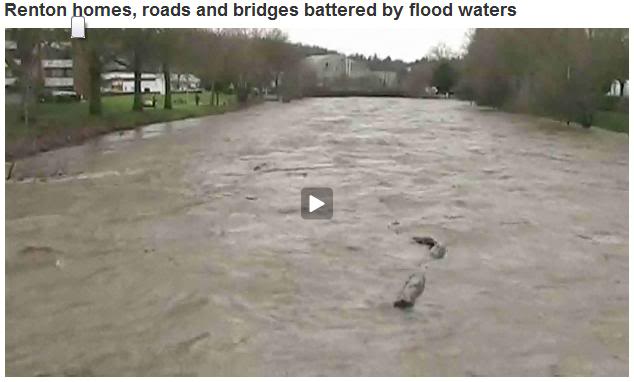
(above)From Renton Reporter video, showing high water in Cedar River through Renton
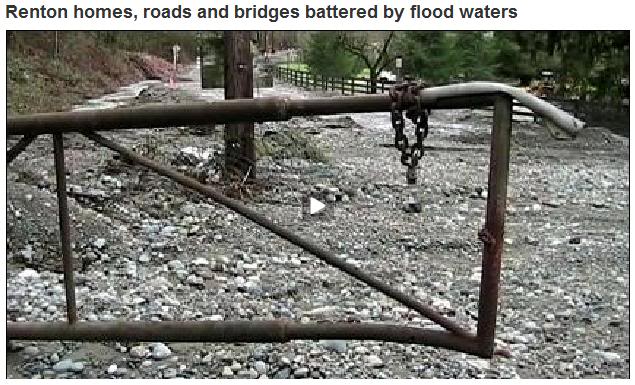
From Renton Reporter video, sand washouts upstream in the Cedar River
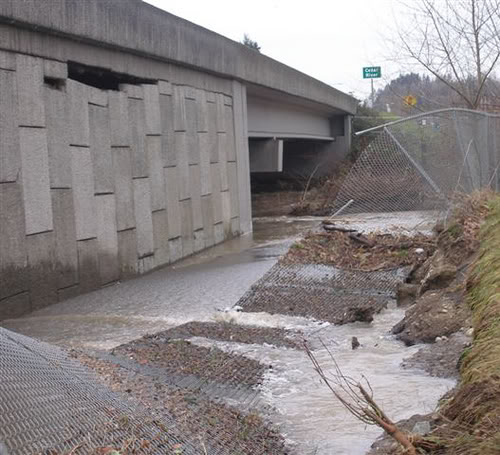
(Above) Maple Valley Highway and one of the DOT bulkheads was damaged by the Cedar River. Replacement of this bulkhead structure and related repairs to the supported highway were estimated at approximately four million dollars.
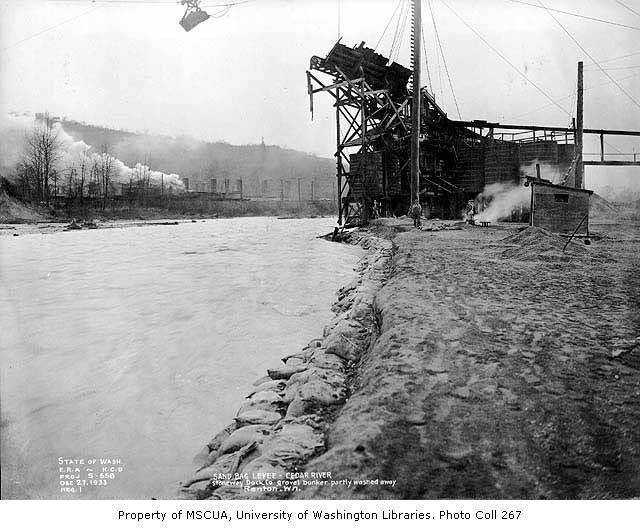
Above, the Stoneway site, with a sandbag levee in 1933.
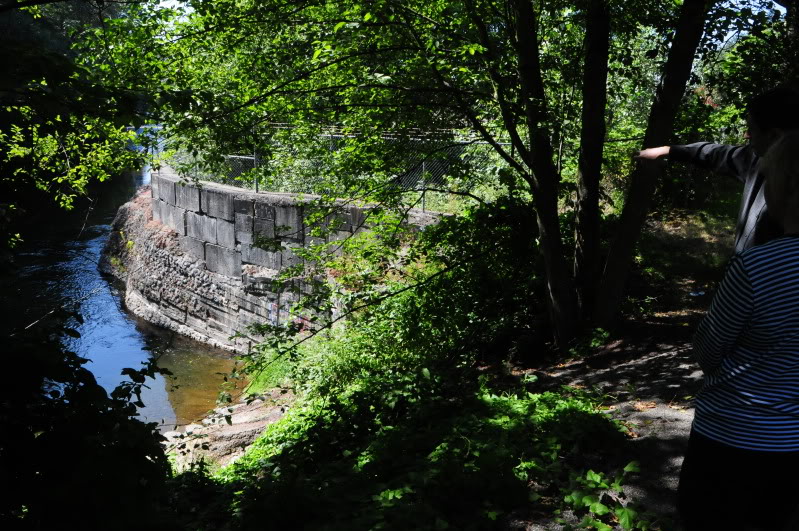
Above, the upstream end of the current Stoneway bulkhead, which has never been damaged by river flooding. This 1200 foot long bulkhead likely helps prevent sand from washing downstream, under Renton’s library and bridges. The owners of the Stoneway site feel that our SMP may cause them to remove this bulkhead.
The issue of how Renton’s updated Shoreline Master Program addresses existing bulkheads on Renton’s waterways has really heated up in the last two weeks. This is different than in the case of NEW bulkheads, where we seem to have largely achieved agreement among property owners (at least the vocal ones), DOE officials, and city officials. (For background on this issue, see my previous blog entry HERE.)
Yesterday we received an email from an expert in geotechnical engineering. In his email he itemizes significant concerns regarding the way we are addressing existing bulkheads.
I feel the concerns have enough merit that we should at least discuss them as a full council. I’m hoping to do this on Monday night. And because this issue could have impacts of tens of millions of dollars on both public and private property, I may wish to refer this topic into Committee of the Whole for a couple of weeks. I’ll explore this on the floor of the council on Monday night, and see if I can get support.
I have my own related concerns about ever-growing deposits of sand and silt under out downtown bridges, and the way these deposits put our downtown properties at risk during storms. Getting dredging permits becomes more difficult each year, and yet we are embarking on rule-making which will increase the potential for these deposits to build up. If I get a chance later today, I will try to describe this concern in more detail.
You can read the email from the Geotechnical expert below. I have also attached his resume for those who wish to know more about him.

Susan Bressler, a Renton Reporter columnist and tireless community volunteer, is reminding us that the Renton Clothes Bank needs extra citizen support during this time of prolonged recession. While the need is greater than ever, the Renton Clothes Bank has lost some of it’s traditional financial backing from other financially-pinched agencies and organizations.
Susan has worked hard over the years to keep clothing flowing into the Clothing Bank. I often see her moving multiple 30-gallon bags of clothes from St Mathews Church out to her car so she can drive them to the Bank for distribution to kids and adults who need them. In addition to clean wearable clothing donations, cash is also extremely appreciated to keep the lights on and to purchase new underclothing and items for babies.
Susan wrote an informative and touching article on this topic for this week’s Renton Reporter. In her article, she tells of a boy who attended school with his shoes repaired by duct tape, and a little girl who had to wear her father’s boxer shorts when she ran out of underwear. With your past assistance, The Renton Clothes Bank has worked hard to prevent such situations– and with your continuing commitment, they can keep making a difference in our community.
Click here to read Susan Bressler’s article in the Renton Reporter.
Please spread the word!
Concerned citizens are holding a special concert for the benefit of, and in honor of, a little girl from our community who had to undergo a liver transplant earlier this year. Little Annie Rowan was mere days away from losing her life when Children’s Hospital performed a miracle transplant on her. While she now has a promising chance of long-term survival, she is still on nine medications and she faces a lifetime of medical treatment.
You can help Annie and her family with past and future medical costs by attending the special “Rock ‘N’ Opera” concert at Benaroya Hall on September 30, 2010 at 7PM in the Nordstrom Recital Hall. You can buy tickets and learn more about this concert by clicking here.
If you can’t make the concert but you want to learn more, donate, or help in other ways click here to go to Annie’s page.
Here is a very touching video that gives a glimpse of Annie’s frightening, then hopeful journey during 2010.
For more information about how you can help Annie, please call Kress Franzen at the website or phone number below:
Kress Franzen
Public Relations Committee chair for COTAforAnnieR.com
425.341.3332
(Thanks to my council colleague Marcie Palmer for bringing this event to my attention)
Sandbag levee protecting Stoneway property in Renton, in 1933. Click here to go the the University of Washington archive source for this photograph.
After my previous blog entry I searched online for a photo of the Stoneway Cedar River bulkhead, a concrete structure that I have seen many times during rafting trips. I never found a photo of the current bulkhead, but I found this photo from 1933, before the bulkhead was built. The sandbags in this photo illustrate why the “Stoneway Docks” Company felt they needed a permanent bulkhead.
As a reminder, the dam which provides some flood protection on Cedar River (and forms the Chester Morse reservoir) was built in 1900, 33 years before this photo was taken.
I think this photo is looking west along the Stoneway site, with the NARCO brick company immediately across the river (current home of the offleash dog park), and Renton Hill in the background– I’ll ask astute readers to please tell me if I’m mistaken on the angle of the photo.
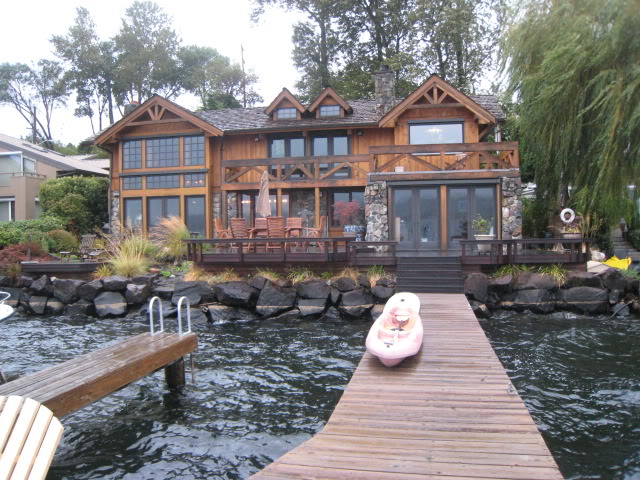 The rock bulkhead on the shoreline of this Renton home provides crucial protection from wave-induced erosion caused by large boats and winter storms. I agree with property owners that existing bulkheads should be entitle to be used throughout their useful service lives even when upland changes are being made.
The rock bulkhead on the shoreline of this Renton home provides crucial protection from wave-induced erosion caused by large boats and winter storms. I agree with property owners that existing bulkheads should be entitle to be used throughout their useful service lives even when upland changes are being made.
After months of hard work by Renton city staff and Renton’s shoreline property owners, the new Renton Shoreline Management Program is getting close to being ready for council approval. (Click here to see my previous articles on this topic). However, I have a remaining concern which relates to the proposed regulation of existing bulkheads. I’ll explain the issue in three parts:
First, my sincere appreciation:
I am grateful to all the affected parties for the collaborative work they have performed to get us to this point. Everyone–city staff, planning commissioners, state officials, shoreline owners, and elected officials–all have demonstrated a strong desire to maintain a healthy shoreline with good wildlife protection. Merging this shared desire with other legitimate interests in recreation, economic development, flood management, and private property rights has taken time and patience. Mayor Law and his senior staff have played an important role in providing the time and opportunity for these issues to get worked out.
Second, some background on riverfront zoning, and on existing bulkheads in general.
For at least two decades, many citizens have requested new ways to enjoy the the Cedar River through water-front dining, water-front cafes, and waterfront event space (for weddings, etc). Under Mayor Jesse Tanner, we rezoned property on the north bank of the Cedar River east of I-405 to accomodate such a vision. (Technically referred to as COR zoning, this allows a broad range of water-front and other types of high-end uses.) The Stoneway Concrete company even moved its concrete batch plant out of this zone to clear the way for this type of multi-use development. We hoped then and still intend to see a river-front “Carillon Point”-type development encompassing the old Stoneway site, the Rivierra Apartments site, and the site of other existing uses which all seem to “turn their back” on the River. The envisioned redevelopment could also include hotels, high-end office space, and condominiums, uses that would work synergistically with Cedar River Park and the Cedar River Trail. Office workers, hotel guests and residents could enjoy lunchtime walks in the park and on the trail, while trail and park users could stop into the new cafes for lunch, snacks, beverages, or simply to get out of a rainstorm. Everyone involved understands that such a development would be subject to a 50-foot building setback from the river. But fifty feet is close enough for the buildings to capture the river’s beauty and sounds, and visitors could dine outside closer to the river’s edge. The SMP should provide enough flexibility so that diners can see the water. Citizens of Renton could enjoy riverfront that is currently inaccessible to the public.

The owners of the Stoneway site and Riviera Apartments are positioned to create hotel, office and waterfront dining space, similar to the Carillon Point Beach Cafe shown above.
The old Stoneway industrial site and the Riviera Apartments site are nicely situated above winter flood waters, and the Stoneway shoreline is protected by a long-standing bulkhead that has proven reliable. Similarly, most developed properties on Lake Washington have bulkheads of some type protecting their homes from the scouring effects of high waves during winter storms. Very few Renton lakeside properties have sufficient land to accommodate a gently-sloping beach. Most have an embankment, protected from sloughing by concrete or rock bulkheads. These bulkheads require substantial design and permitting efforts in addition to the costs of construction, and can cost more than one hundred thousand dollars on many home sites. Renton has installed many flood control measures and lakeside bulkheads on public property, such as the flood walls along the airport, and bulkheads near our restaurants in Coulon Park. And it’s not just Renton–last year our region created a new taxing district to pay for new levees and flood protections on the Green River, while the City of Seattle has been undergoing contortions trying to find funding for a new sea wall to protect its Puget Sound waterfront.
As a city official and a taxpayer, I’m appreciative of those riverfront and lakefront property owners who have used their private funds and negotiated the labyrinth of permitting agencies, hired the contractors, and installed storm protection for their property. When urban shorelines have inadequate flood and storm protection, we all end up paying for it one way or another. Left to nature, rivers will meander and scour– it’s what they do. They remove sediment on the high-velocity outside edge of river bends, undercut natural embankments, and carve wider and wider valleys. It’s a beautiful thing in an alpine meadow or at the Grand Canyon, but it is generally disastrous within an urban area like Renton.
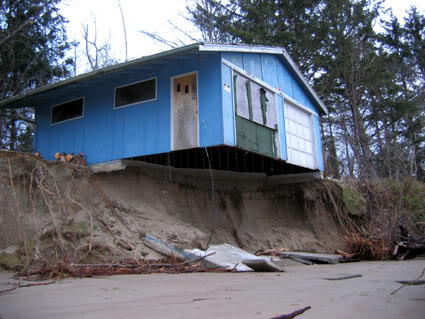
Washaway Beach, on the Washington coast, provides a dramatic demonstration of the destructive power of shoreline erosion.
Finally, here is my concern.
The problem with the current draft of Renton’s SMP is that, if adopted, it would require property owners to evaluate removal or reduction of their existing protective bulkheads if the owner adds 1000 square feet or more of new construction to his/her property, or proposes a change in use of the property, even if the owner plans no change to the bulkhead. Under the draft SMP’s current language, the property owner would be required to hire a geotechnical engineer who would opine whether the bulkhead is necessary to protect the property from imminent damage during only THE THREE YEARS following the engineer’s review, an unreasonably short time in view of the uncertainty regarding when the next big storm will hit. If, in the opinion of the engineer, the property would not be imperiled in the next three years without the bulkhead, then the bulkhead would have to come out or be modified at great expense to a different design–or else the homeowner would not be allowed to do the 1000 square-foot addition.
To make matters worse, even if the engineer concluded that the existing bulkhead was needed, there could be a series of time-consuming and expensive reviews and appeals of this decision by government agencies or other persons.
While it is laudable to want to restore the lake and river shorelines to the most natural state possible, the primary effect that this proposed policy governing existing bulkheads will have is to keep residential and business properties from being remodeled or redeveloped. Property owners will be very reluctant to take on a building expansion or replacement project if they are faced with the risk of having to modify their existing bulkheads, structures that often may have 50 or 100 years of useful service life left in them.
Furthermore, this proposed new requirement is throwing doubt and confusion at the owners of property along the Cedar River where the city has done massive legwork–and even negotiated removal of a concrete plant–to prepare for future cafes, restaurants, and hotels (“Carillon Point on the River”). The current SMP language raises the specter that the existing bulkheads on the Cedar River shoreline might be required to come out as a condition of site redevelopment. Anxiety stemming from that specter is likely to dampen redevelopment prospects for the old Stoneway site.
I think a much better approach would be for the SMP to read that when a bulkhead is ultimately replaced–which will happen when it’s reached the end of its serviceable life (such as when the concrete crumbles, the steel rusts through, the wood rots away, or the entire bulkhead is undercut by the river or lake)–AT THAT TIME the need for the bulkhead should be reviewed by an appropriate engineer and local and state agencies. That would be the point in time at which all interests logically converge. That is the time that the shoreline must be disturbed to remove or replace the bulkhead. And that is the time that the property owner is forced by nature (not the city) to pay for studies and reconstruction.
The text of the state SMP guidelines supports the view that the right time to review the need for existing bulkheads is when the bulkheads are being replaced. So I believe the Department of Ecology and other stakeholders would accept this change.
With such a change I feel we would be about ready to approve the SMP.
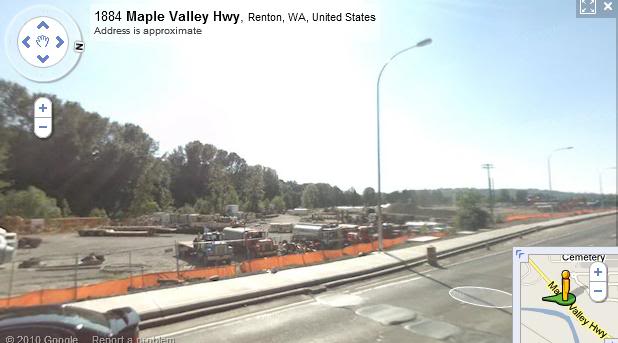
For reference, the river-front Stoneway Industrial site in it’s current condition.
Hi, I’m Randy Corman. Welcome to my blog! I served on Renton City Council for 28 years, 1994-2021, with six years as Renton Council President. I’m also a mechanical engineer and manager, and worked for the Boeing Company for 33 years, from 1984- 2017. My wife and I have five kids and six grandkids, and we all live in Renton. I’ve kept this blog for 19 years, and get thousands of readers each month. Please share your feedback, ideas, and opinions in the comments.
Your comments are very appreciated and they add value to this blog. You may comment anonymously by leaving your name and email out of the comment form (there is no sign-in required). Please keep your comments civil and respectful; policy discussions are encouraged but avoid personal attacks. No threats of violence against anyone, or inciting violence in any form. No racist, sexist, or hateful comments of any kind. Be truthful. Do not make allegations of criminal, unethical, or other personal wrongdoing that you do not have proof to back up. Avoid profane, obscene, vulgar, lewd, discriminatory, or sexually-oriented language. Honest, respectful, good-faith discussion of public officials’ actions and their results are protected speech. Private persons deserve more discretion, so avoid any unfair criticism of them.
Admin login • EvoLve theme by Theme4Press • Powered by WordPress Renton Community Update
News from former Councilmember Randy Corman, your Renton City Hall insider. (All views expressed in journal entries are Randy Corman's personal views, and not the official position of the City of Renton or other city employees. Views expressed in reader comments are those of the commenter)

Recent Comments